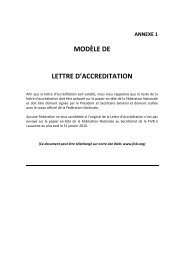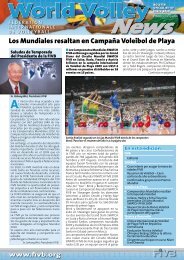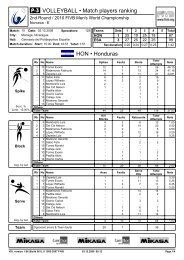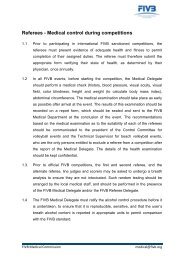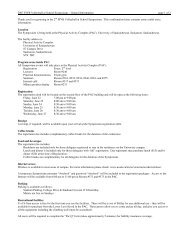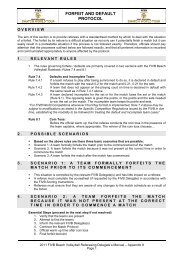MEDICAL REGULATIONS 11 Edition - FIVB
MEDICAL REGULATIONS 11 Edition - FIVB
MEDICAL REGULATIONS 11 Edition - FIVB
Create successful ePaper yourself
Turn your PDF publications into a flip-book with our unique Google optimized e-Paper software.
<strong>FIVB</strong> Medical Regulations – <strong>11</strong>th <strong>Edition</strong><br />
Macronutrients: Carbohydrate, Fat & Protein<br />
The human body can metabolize energy from three dietary sources: carbohydrate, fat, and<br />
protein. Carbohydrate is the primary source of energy for all athletes. Fat is an important<br />
energy source for events that last several days. Protein is usually not used for energy,<br />
unless energy intake is less than energy expenditure. Yet, adequate amounts of dietary<br />
protein are needed for muscle building and repair after physically demanding activity.<br />
Carbohydrate: Most athletes benefit from consuming a high carbohydrate diet.<br />
Carbohydrate-rich foods are characterized by the Glycemic Index (GI), which is an<br />
indicator of how rapidly blood sugar levels rise in response to the type of carbohydrate<br />
ingested. When consumed, high GI foods increase blood sugar levels rapidly, whereas<br />
medium and low GI foods take longer to digest and thus cause more gradual increases in<br />
blood sugar. Each type of carbohydrate has a place in the athlete's diet.<br />
High GI Foods such as sugary cereals, hard candies, juices, fruit drinks, non-diet<br />
soda pop, sport drinks, white bread, and some nutrition bars largely contain<br />
primarily simple carbohydrates, or sugars. Some of these foods are sources of<br />
quick energy but provide few or none of the essential vitamins and minerals. High<br />
GI foods, particularly sport drinks, are beneficial during intense training and<br />
competition, as well as during recovery.<br />
Medium & Low GI Foods such as brown rice and whole grain breads, cereals<br />
and pasta are sources of complex carbohydrates that provide energy as well as<br />
essential nutrients. Legumes (peas and lentils) and beans are rich in both<br />
carbohydrate and protein. Vegetables and fruits contain mixtures of simple and<br />
complex carbohydrates and are loaded with essential nutrients. It is important to<br />
include a variety of these foods in most, if not all, meals.<br />
Protein: Athletes need about 250 grams of protein a day, which can be obtained by eating<br />
5-6 servings of protein-rich foods such as 85 grams of meat, 250 mL of cottage cheese, or<br />
a glass of milk. The majority of daily protein calories should come from foods that provide<br />
high quality protein containing all of the essential amino acids.<br />
Sources of high quality protein: lean meats and poultry, fish (fresh and canned),<br />
egg whites, dairy products (milk, cheese, cottage cheese, yogurt), and tofu.<br />
Plant sources (lower quality): mushrooms, legumes, beans, pasta, whole grains,<br />
nuts.<br />
Fat: Although fat is a major source of energy, excessive intakes can cause unwanted<br />
weight gain and adversely affect performance. Fats should be eaten in moderation. Fats<br />
differ in their nutritional and health values.<br />
Limit saturated fat found in butter, rich creamy desserts and some salad<br />
dressings, pastry, animal products (bacon, fatty meats), and deep-fried foods.<br />
Supply in moderation mono- and poly-unsaturated fats that are found in fatty<br />
fish, such as salmon, and plant-based foods, such as peanut butter, nuts,<br />
seeds, and plant oils.<br />
- 42 -



